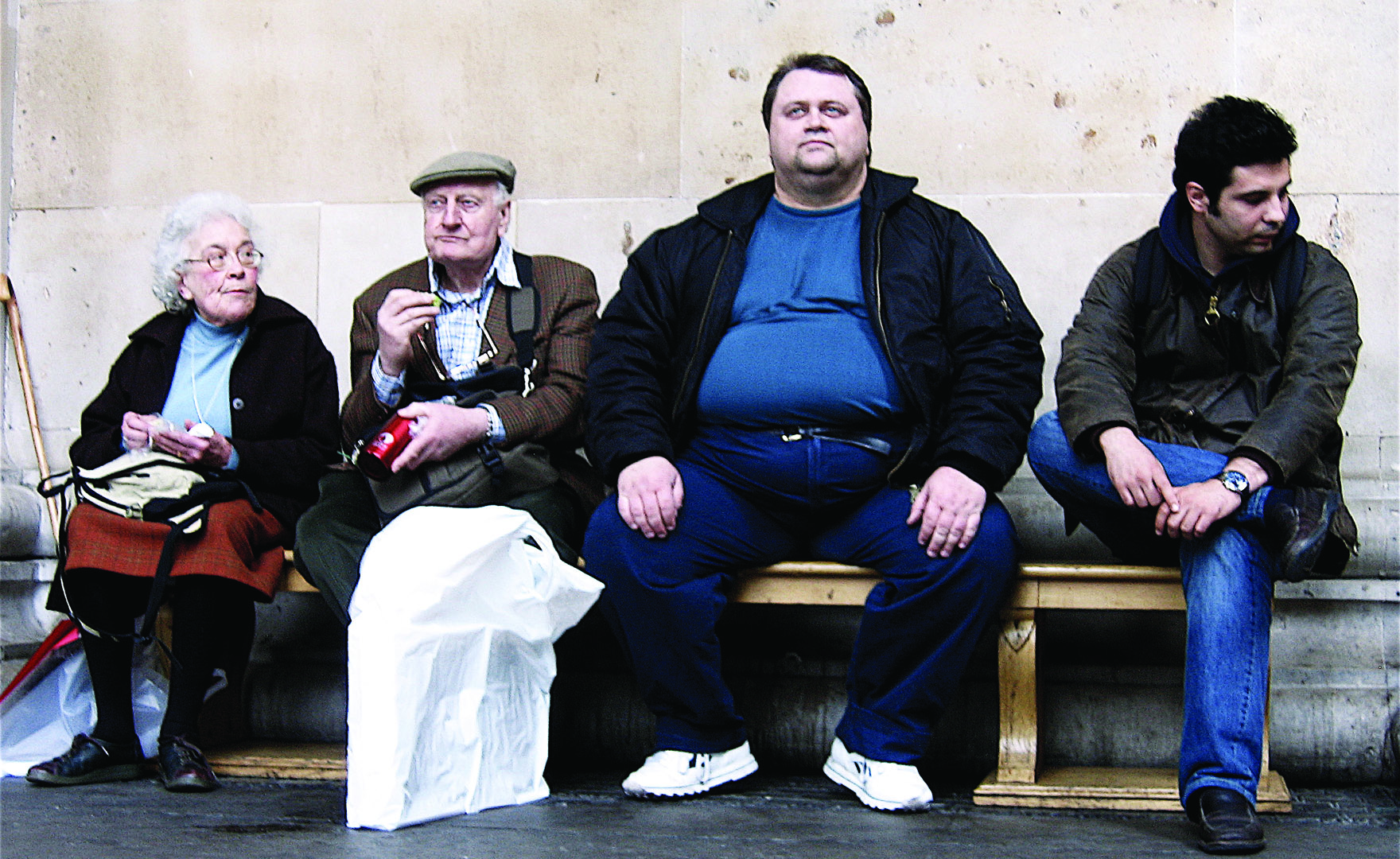There are multiple reasons many of our societies are getting fatter and finding workable solutions can be just as complex
“It is no measure of health to be well adjusted to a profoundly sick society.” – Jiddu Krishnamurti, philosopher
It’s often used to refer to mental health, but the human drive to model ourselves on others could become dangerous in a society that is getting heavier and heavier.
This raises the question, what will happen if we start measuring our own waistlines against those of our “sick peers”?
According to a three-decade study of American adults, the population is becoming ever fatter despite the fact that the proportion of people trying to lose weight has shrunk.
Analysing data from 27,300 US adults, including asking whether they’d tried to lose weight in the past 12 months, the researchers found that between 1988 and 1994, one in two participants were overweight or obese.
But by 2009-2014, that proportion had jumped to two out of every three people meeting the BMI criteria for overweight or obese, the highly-regarded National Health and Nutrition Examination Survey (NHANES) showed.
Yet despite more people being above the normal weight range, the proportion who said they were trying to lose weight slipped from 56% to 49% over the same period.
The authors provided several possible explanations for these findings, including that “body-weight misperception” could be reducing the motivation to engage with weight-loss efforts. In other words, people might underestimate the effects of their weight on health, and so feel less compelled to do something about it.
A previous study performed on the NHANES dataset1 had found fewer people considered themselves overweight as time went on, the authors said.
Another US study also seems to support the idea that we might not have an accurate gauge on how big we really are, finding that 23% of overweight women inaccurately estimated their BMI.2
Those women were also less likely to report trying to lose weight than overweight women who accurately estimated their BMI.
And men were just as bad, if not worse, at recognising whether they were overweight, said former GP Professor John Dixon, now head of clinical obesity at the Baker Heart and Diabetes Institute.
“People don’t recognise even class-one obesity as being big anymore,” he says. “It’s not until you look back at pictures of 20 years ago or 30 years ago, that you stop and think ‘my God, we’ve got a community that has become more bloated’.”
If you’re measuring yourself against other people, and other people are getting bigger, suddenly it seems like you’ve got less of a weight problem than you really do.
So what happens when obesity becomes the new normal?
Dr Georgia Rigas, chair of the RACGP’s Obesity Network, says obesity has a major impact at many levels.
The designing and building of our world has been done with a certain-sized human in mind, and so beyond obvious annoyances like finding well-fitting clothes, bigger people just struggle to fit in sometimes.
Seats on trains, planes and in cinemas are more than just uncomfortable – they might trigger shame, embarrassment and fear about not fitting in or spilling over to the next seat.
Imagine the feeling of going into a restaurant to only find booths or fixed seats you are too small for, or resting your gut on top of a table to be close enough.
Turnstiles and theme parks can range from inconvenient or altogether impossible, and the stability of chairs in public can be a source of anxiety.
Already, companies, governments and individuals are having to accommodate for the growing sizes of our citizens.
Perth and Adelaide cricket grounds have decided to put in larger seats with more leg room to adjust to the sizes of the people who come to watch a game.
As well, airline companies are struggling to deal with how to fit larger passengers into seats that can be narrow and uncomfortable at the best of times.
In 2013, Samoa Air was the first to charge customers for the combination of their body weight and luggage. Since then, various airlines have courted controversy for measures responding to the practical implications of the obesity epidemic.
Meanwhile, cars need to be modified to ensure the steering wheel and seat have enough space, and a heavier population may also be making it more difficult to reach fuel-efficiency targets.
A 2009 report estimated vehicles in the US were using more than four billion extra litres of fuel per year hauling around the excess weight the population had put on since 1962.3
Of course, in some cases there might be a chicken-egg scenario occurring here, with a follow-up paper by the same author showing a close link between the distance driven and a person’s tendency to be obese six years later.4
Hospitals and ambulances also need to have the capacity to deal with larger people – reinforcing gurneys, widening doors and installing sturdier floor-mounted toilets.
In general practice, there is also the need to have the right equipment for the patients who walk through the door.
As a GP, Dr Rigas says she was so frustrated and embarrassed by not having the right equipment for her patients that she ordered a large blood-pressure cuff and went to Bunnings to get a two-metre tape measure to ensure that nobody would walk into her office and not be able to have their waist measured. “It embarrasses and stigmatises patients if you put them on a scale and it only goes up to 150kg and they are more than that,” she says.
But it’s not just about responding to the growing size of patients seeing their GP, with the authors of the NHANES study suggesting fewer people may be prompted to talk about their weight by their doctor.
This explanation rings true for Dr Rigas, who says the guidelines on managing obesity are not being adhered to.
The RACGP’s Red Book recommends all adults and adolescents have their BMI and waist circumference measured every two years and recorded in their medical record.
This should be done annually for those with diabetes, cardiovascular disease, gout, liver disease, or from high risk groups such as Aboriginal and Torres Strait Islanders.
And patients already overweight or obese should be getting their BMI and waist circumference measured every six months.
Nevertheless, Dr Rigas notes that a 2015 study published in the MJA, by GP Professor Danielle Mazza, found only one in five patients visiting their GPs had a BMI measured in the previous two years.
Only 4.3% of the 270,000 Melbourne adults in the study had their waist circumference measured, they found.
BEACH data also echoes these findings, showing fewer than 1% of GP consultations focus on obesity.
While a positive finding of the MJA paper was that elderly people and those with diabetes, hypertension and hyperlipidaemia were more likely to have a recorded BMI, it needs to happen more often, Dr Rigas says.
“The fact that a health professional doesn’t raise the issue of weight and how it affects the individual’s health inadvertently sends the message that it is okay for them to be that size,” she says.
“We’re actually doing them a disservice, and it’s at their detriment.” Because discussing weight does help, Dr Rigas says.
A 2014 US study found that overweight and obese participants were significantly more likely to report 5% weight loss in the past year if their doctor had told them they were overweight.5
“Rates of obesity are increasing and so whatever we are doing, or not doing, is clearly ineffective,” Dr Rigas says.
She says we need to adopt different approaches, quoting the old saying, “insanity is doing the same thing over and over again but expecting a different result”.

Why should I bother?
Another possible explanation for the shrinking number of people trying to lose weight is that people are simply giving up.
“If you’re an obese person, and you’ve tried 10 diets, and you’ve tried exercising and you’ve tried everything else and it hasn’t worked, then why would you not give up?” Professor Dixon says.
We know that the body physiologically defends against weight loss, just like the body titrates blood pressure and other parameters, Dr Rigas says.
A good illustration of this is a study published last year of contestants from the reality television show The Biggest Loser. Six years after competing in the intensive weight loss course, almost all the participants had regained the weight lost, and their metabolism had slowed by several hundred calories a day.6
“Interventions like diet and exercise, pharmacotherapy and bariatric surgery help to lose weight, but the moment they stop that intervention the body gets them back to that set point weight,” Dr Rigas says.
Even when we try to do everything right, our bodies do their best to hold onto fat and protect against further weight loss.
Dr Rigas says that with highly processed food readily available, and an increasingly sedentary existence where people are not expending as much energy as they used to, it is a “recipe for disaster”.
“People are simply meeting their genetic potential,” Dr Rigas says.
So what do we do?
A similar sense of frustration drives things on the medical side, Professor Dixon says.
“The struggle comes down to … not having access and not having facilities to adequately treat anyone,” Professor Dixon says. “So what’s the point in the GP measuring the child, what’s the point in measuring body mass index of an adult if they don’t have at their fingertips solutions that are likely to make a difference?”
Meanwhile, the fat-acceptance movement has gained traction as overweight and obese people fight back against stigma and discrimination.
Overlapping with this is Health at Every Size, a movement advocating healthy habits independent of the goal of losing weight.
The argument here is that dieting is largely ineffective, either at losing weight or keeping it off, and that “yo-yo” dieting is even more harmful than having a stable, if higher, weight. While the primary aim of both is to promote body positivity and self-love, combating the attacks on people’s self-esteem if they are heavier, there is also a thread in these movements that is sceptical that a high BMI necessarily means the person is unhealthy.
Rates of obesity are increasing and so whatever we are doing, or not doing, is clearly ineffective.
A focus on fit rather than fat is not a bad thing, according to Associate Professor Amanda Salis, at the University of Sydney’s Boden Institute of Obesity, Nutrition, Exercise & Eating Disorders.
“But I think when it comes to excess weight, there’s no room for acceptance,” Professor Salis says.
Even in those that appear cardio-metabolically healthy, excess weight causes adverse impacts on joints and is linked to an increased risk of cancer, she says.
It could also be that obesity is considered normal on a societal level, too.
Professor Dixon is frustrated at the lack of political will and resources put towards combating the problem.
“It’s not a sexy area to work in,” he says, pointing to the lack of obesity specialists when compared with cardiovascular, diabetes or cancer specialists.
There are three weight-loss medicines that have been approved by the TGA, but none are on the PBS.
“Access to bariatric surgery is largely to people with private health insurance,” he says, which is out of whack with those who most need it.
“They just live with their disease, and we watch their disease, and they die of their disease,” he says.
“And it’s a tragic thing to watch.
“We know most of the likelihood of becoming obese is genetic, and then programming when in utero or in the first years of life,” Professor Dixon says.
Once you’re an adolescent, the die is cast on your weight for life, given an environment.
“We don’t expect change unless we can really do quite a makeover of our environment.”
References
1. https://www.ncbi.nlm.nih.gov/pubmed/19875997
2. https://www.ncbi.nlm.nih.gov/pmc/articles/PMC3005306/
3. https://www.researchgate.net/publication/229094448_Measuring_the_potential_for_automobile_fuel_savings_in_the_US_The_impact_of_obesity
4. https://pdfs.semanticscholar.org/a6f6/6566b10e5d39e6b4252bafc09f42a0a059ae.pdf
5. https://www.ncbi.nlm.nih.gov/pmc/articles/PMC4264677/
6. https://www.ncbi.nlm.nih.gov/pubmed/27136388


